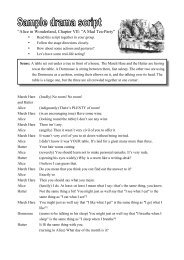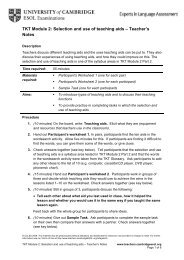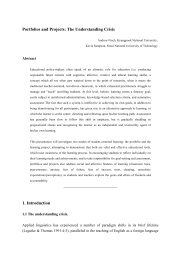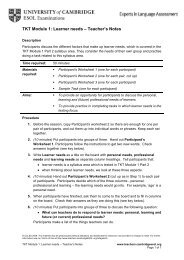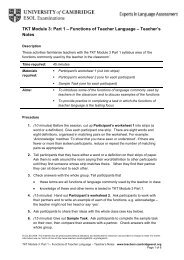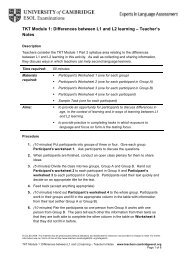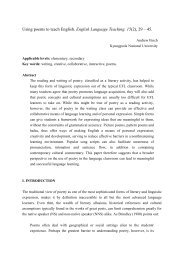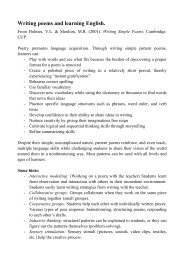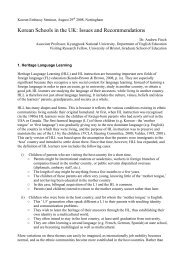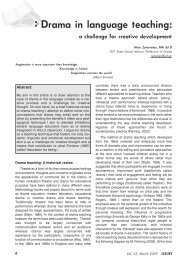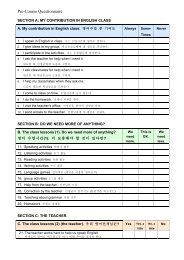TKT Module 3: Part 1 â Functions of Learner Language ... - Finchpark
TKT Module 3: Part 1 â Functions of Learner Language ... - Finchpark
TKT Module 3: Part 1 â Functions of Learner Language ... - Finchpark
You also want an ePaper? Increase the reach of your titles
YUMPU automatically turns print PDFs into web optimized ePapers that Google loves.
<strong>TKT</strong> <strong>Module</strong> 3: <strong>Part</strong> 1 – <strong>Functions</strong> <strong>of</strong> <strong>Learner</strong> <strong>Language</strong> – Teacher’sNotesDescriptionThis activity will familiarise teachers with some <strong>of</strong> the terminology relating to the <strong>TKT</strong> <strong>Module</strong>3 <strong>Part</strong> 1 syllabus area <strong>of</strong> ‘identifying the functions <strong>of</strong> language used by learners in theclassroom’.Time required:40 minutesMaterialsrequired:• <strong>Part</strong>icipant’s worksheet 1 (cut into strips)• <strong>Part</strong>icipant’s worksheet 2 (one for each participant)• Sample Task (one for each participant)Aims: • To introduce some <strong>of</strong> the functions <strong>of</strong> language commonly used bylearners in the classroom and to discuss examples <strong>of</strong> the functions.• To provide practice in completing a task in which the functions <strong>of</strong>teacher language is the testing focus.Procedure1. (10 minutes) Before the session, cut up <strong>Part</strong>icipant’s worksheet 1 into stripscontaining a word or a definition. Give each participant one strip. There are eightwords and eight definitions, organised in matching pairs on the worksheet. Forexample: ‘Clarify’ matches with ‘To make clear what you mean’. If there are fewerthan sixteen participants, make sure that you give out words that match with adefinition. If there are more than sixteen participants, use some <strong>of</strong> the strips morethan once but make sure that you provide matching pairs <strong>of</strong> words and definitions.2. Tell participants that they have either a word or a definition on their strips <strong>of</strong> paper.Ask them to walk around the room saying their word/definition to other participantsuntil they find someone whose strip matches with theirs. When they find theirpartner they can sit down next to each other.3. Check answers together (see key below). Tell participants that• these terms are all functions <strong>of</strong> language commonly used by learners in class• knowledge <strong>of</strong> these and other terms is tested in <strong>TKT</strong> <strong>Module</strong> 3 <strong>Part</strong> 1.4. 15 minutes Hand out <strong>Part</strong>icipant’s worksheet 2. Ask participants to work with theirpartners and to write an example <strong>of</strong> each <strong>of</strong> the functions. For example: Agree – thelearner might say “You’re right”.5. Get participants to share their ideas with the whole group (see key below).6. 10 minutes Give out the Sample Task. Ask participants to complete the sampletask on their own then compare their answers with a partner, before checkinganswers with the whole group.© UCLES 2009. This material may be photocopied (without alteration) and distributed for classroom use provided no charge is made. For furtherinformation see our Terms <strong>of</strong> Use at http://www.teachers.cambridgeESOL.org/ts/legalinfo<strong>TKT</strong> <strong>Module</strong> 3: <strong>Part</strong> 1 – <strong>Functions</strong> <strong>of</strong> <strong>Learner</strong> <strong>Language</strong> – Teacher’s Noteswww.teachers.cambridgeesol.orgPage 1 <strong>of</strong> 6
7. 5 minutes Round up to summarise points covered. Ask participants:• What is the <strong>TKT</strong> <strong>Module</strong> 3 syllabus area for this lesson? (functionscommonly used by the learner in the classroom)• What are candidates being tested on? (Candidates are tested on theirknowledge <strong>of</strong> and ability to identify common functions and typical exponents)• How can candidates prepare for this area <strong>of</strong> the syllabus? (Candidates canstudy the list <strong>of</strong> examples <strong>of</strong> learner language in the <strong>TKT</strong> Glossary which is on theCambridge ESOL website).© UCLES 2009. This material may be photocopied (without alteration) and distributed for classroom use provided no charge is made. For furtherinformation see our Terms <strong>of</strong> Use at http://www.teachers.cambridgeESOL.org/ts/legalinfo<strong>TKT</strong> <strong>Module</strong> 3: <strong>Part</strong> 1 – <strong>Functions</strong> <strong>of</strong> <strong>Learner</strong> <strong>Language</strong> – Teacher’s Noteswww.teachers.cambridgeesol.orgPage 2 <strong>of</strong> 6
<strong>TKT</strong> <strong>Module</strong> 3: <strong>Part</strong> 1 – <strong>Functions</strong> <strong>of</strong> <strong>Learner</strong> <strong>Language</strong> – AnswerKeysKey to Procedure Step 3Agree - To have the same opinion as someone elseApologise - To say sorry for somethingAsk for clarification - To ask for an explanation <strong>of</strong> what a speaker meansAsk for repetition - To ask someone to say what they have just said againClarify - To make clear what you meanContribute - To give or add something to a discussion by taking part and giving ideasHesitate - To pause before or while doing or saying somethingUse fillers - To use a word or sound which fills the time while you are thinking <strong>of</strong> what tosayKey to Procedure Step 51. Agree: You’re right, I agree, I think so too; yes2. Apologise: I’m sorry, I’m terribly sorry, Sorry about that.3. Ask for clarification: What do you mean? Sorry, I don’t understand4. Ask for repetition: Sorry, could you say that again. I didn’t hear that could yourepeat it, please?5. Clarify: What I mean is .. What I want to say is…6. Contribute: I think it’s a good idea to improve the public transport system then therewould be fewer cars; Yes, and I think...7. Hesitate: I’m going on (pause) holiday next week.8. Use fillers: Umm, Er, How shall I say?Key to Sample Task1. C 2. A 3. A 4. C 5. B© UCLES 2009. This material may be photocopied (without alteration) and distributed for classroom use provided no charge is made. For furtherinformation see our Terms <strong>of</strong> Use at http://www.teachers.cambridgeESOL.org/ts/legalinfo<strong>TKT</strong> <strong>Module</strong> 3: <strong>Part</strong> 1 – <strong>Functions</strong> <strong>of</strong> <strong>Learner</strong> <strong>Language</strong> – Answer Keyswww.teachers.cambridgeesol.orgPage 3 <strong>of</strong> 6
<strong>TKT</strong> <strong>Module</strong> 3: <strong>Part</strong> 1 – <strong>Functions</strong> <strong>of</strong> <strong>Learner</strong> <strong>Language</strong> –<strong>Part</strong>icipant’s Worksheet 1AgreeTo have the same opinion as someone else.ApologiseTo say sorry for something.Ask for clarificationTo ask for an explanation <strong>of</strong> what a speaker means.Ask for repetitionTo ask someone to say what they have just said again.ClarifyTo make clear what you mean.ContributeTo give or add something to a discussion by taking part and giving ideas.HesitateTo pause before or while doing or saying something.Use fillersTo use a word or sound which fills the time while you are thinking <strong>of</strong> what to say.© UCLES 2009. This material may be photocopied (without alteration) and distributed for classroom use provided no charge is made. For furtherinformation see our Terms <strong>of</strong> Use at http://www.teachers.cambridgeESOL.org/ts/legalinfo<strong>TKT</strong> <strong>Module</strong> 3: <strong>Part</strong> 1 – <strong>Functions</strong> <strong>of</strong> <strong>Learner</strong> <strong>Language</strong> – <strong>Part</strong>icipant’s Worksheet 1www.teachers.cambridgeesol.orgPage 4 <strong>of</strong> 6
<strong>TKT</strong> <strong>Module</strong> 3: <strong>Part</strong> 1 – <strong>Functions</strong> <strong>of</strong> <strong>Learner</strong> <strong>Language</strong> –<strong>Part</strong>icipant’s Worksheet 2Work with a partner and provide an example for each <strong>of</strong> these functions <strong>of</strong> learnerlanguage in the classroom1. Agree - To have the same opinion as someone else.Example - “You’re right”.2. Apologise - To say sorry for something.Example:3. Ask for clarification – To ask for an explanation <strong>of</strong> what a speaker means.Example:4. Ask for repetition - To ask someone to say what they have just said again.Example:5. Clarify - To make clear what you meanExample:6. Contribute - To give or add something to a discussion by taking part and giving ideas.Example:7. Hesitate - To pause before or while doing or saying somethingExample:8. Use fillers - To use a word or sound which fills the time while you are thinking <strong>of</strong> what tosay.Example:© UCLES 2009. This material may be photocopied (without alteration) and distributed for classroom use provided no charge is made. For furtherinformation see our Terms <strong>of</strong> Use at http://www.teachers.cambridgeESOL.org/ts/legalinfo<strong>TKT</strong> <strong>Module</strong> 3: <strong>Part</strong> 1 – <strong>Functions</strong> <strong>of</strong> <strong>Learner</strong> <strong>Language</strong> – <strong>Part</strong>icipant’s Worksheet 2www.teachers.cambridgeesol.orgPage 5 <strong>of</strong> 6
<strong>TKT</strong> <strong>Module</strong> 3: <strong>Part</strong> 1 – <strong>Functions</strong> <strong>of</strong> <strong>Learner</strong> <strong>Language</strong> – SampleTaskFor questions 1–7, read the conversation between two advanced learners. Answer thequestions about their use <strong>of</strong> language by choosing the correct option A, B, or C.Cristina:Raquel:Cristina:Raquel:Cristina:Raquel:Are you a good sailor? Have you ever been seasick?Yeah, I have been seasick, once. Actually, I…Was that on a long journey?Yeah. In fact, I’m quite a good traveller normally. But there was erm…er… not on along journey, no, sorry. It was about only 30 kilometres. And erm, coming … on theway back. It was a very small boat, and it was very hot, and me and the rest <strong>of</strong> myfamily were on the very….in the inside <strong>of</strong> the boat. And it was just like being on a …on a cork, carried by water. And my brother started first, and then everyone startedfeeling sick.Oh, terribleIt was horribleline 2line 4line 5line 8line 10line 111 Why does Raquel stop after saying ‘Actually I …’? (line 2)ABShe can’t remember the right word.She hasn’t understood the question.C She is suddenly interrupted by Christina.2 Why does Raquel say ‘Yeah’ at the beginning <strong>of</strong> line 4?ABto show she heard Christina’s questionto ask for the question to be repeatedC to show she’s unsure about her answer3 Why does Raquel use ‘in fact’? (line 4)ABShe’s introducing a contrast with what she said earlier.She’s correcting what Christina said.C She’s giving herself some time to think.4 The many uses <strong>of</strong> ‘and’ in lines 5–8 in Raquel’s storyABsummarise Raquel’s ideas.repeat what happened in the story.C mark new points in the story.5 The adjectives ‘terrible’ and ‘horrible’ (lines 10 and 11) show that Raquel andCristina bothABCdislike the way Raquel told the story.have the same reaction.have had a similar experience.© UCLES 2009. This material may be photocopied (without alteration) and distributed for classroom use provided no charge is made. For furtherinformation see our Terms <strong>of</strong> Use at http://www.teachers.cambridgeESOL.org/ts/legalinfo<strong>TKT</strong> <strong>Module</strong> 3: <strong>Part</strong> 1 – <strong>Functions</strong> <strong>of</strong> <strong>Learner</strong> <strong>Language</strong> – Sample Taskwww.teachers.cambridgeesol.orgPage 6 <strong>of</strong> 6



